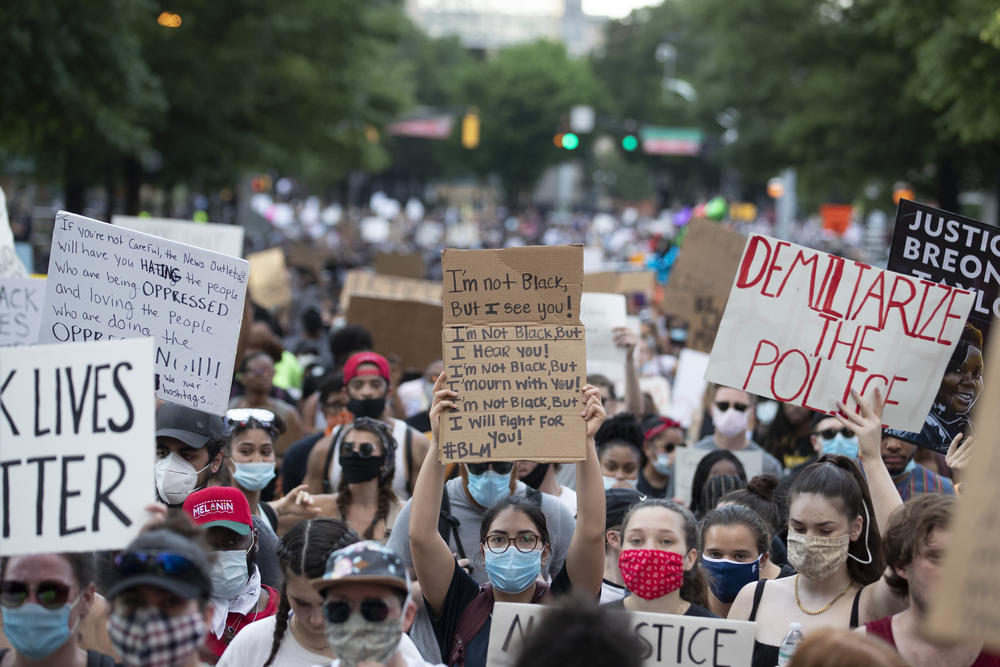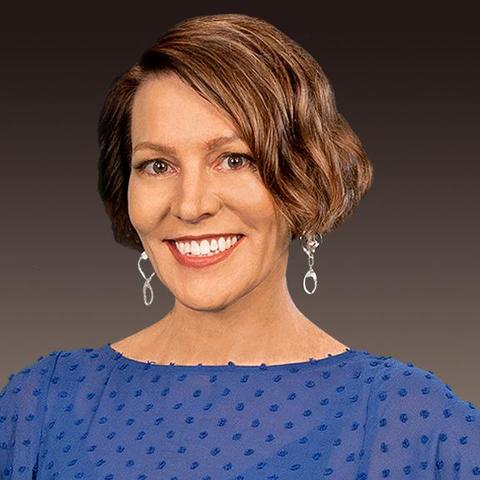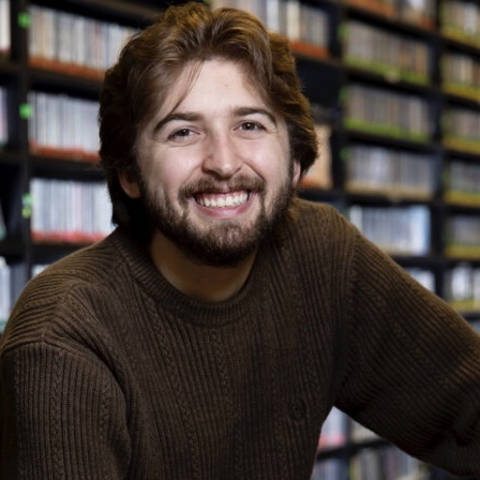Section Branding
Header Content
Georgians Demand Justice: The Messages And Momentum Behind The George Floyd Protests
Primary Content
Since George Floyd was killed by a Minneapolis police officer on May 25, rage that had accumulated over centuries of racial violence spilled into the nation's streets.
From Atlanta, Macon and Savannah to London, Amsterdam and Paris, protesters are flooding streets that, only weeks ago, stood nearly empty due to fears of COVID-19. The crowds are unprecedented in their size, diversity and condemnation of police brutality and systemic racial injustice. Despite early property damage, largely peaceful protests have gained momentum over the course of the last week.
To understand the motivations and historical context behind the movement, On Second Thought invited a panel of guests to weigh in on the meaning behind these protests, the legacy of resistance to racism, and meaningful changes that would lead to a more equitable future.
“I’m tired of seeing hashtag after hashtag, black man after black man, black woman after black woman, black trans woman after black trans woman, killed in the media,” shared D’Angelo Morrison, who is director of services and advocacy at the non-profit He Is Valuable. “I’m tired of the police officers harassing my community in this way. And the message from me is: stop. I’m done; we’re all done. We have to end this, now.”
Morrison has attended most of the protests since they began last week and he notes that, while he’s demonstrated for many causes in the past, this is the first time he’s felt that his life was threatened.
RELATED: Interview: Killer Mike Talks Atlanta Protests, 'Kill Your Masters' T-Shirt
Reverend Kim Jackson of the Church of the Common Ground has also attended numerous demonstrations as a protest chaplain. She compared what she is seeing now in Atlanta to what she witnessed in 2014 in Ferguson, Missouri, after the police killing of Michael Brown.
“When people line up in front of a police officer and they tell their story, whether I’m in Ferguson or in Atlanta, those stories are remarkably the same,” she said. “That’s what I’m hearing: this bubbling over of frustration. Yes, people want justice for George Floyd — and people want justice in their own cities, and their own backyards.”
Dr. Maurice Hobson, historian and associate professor of African American studies at Georgia State University, weighed in on the historical context and significance of protest movements.
“I want to tell you something about the black experience,” he said. “Wherever you’ve seen the most oppression, you’ve seen the most resistance. Black people have been fighting like hell the whole time.”
Hobson, author of The Legend of the Black Mecca: Politics and Class in the Making of Modern Atlanta, pointed to history — including the formation of the National Guard to control enslaved Africans, Booker T. Washington’s “Atlanta Compromise” agreement in 1895, and the city’s Red Dog police force formed in the 1980s — to illustrate enduring inequities and the uneasy relationship between black communities and the police.
“This city has erupted before. It has erupted quite a bit,” Hobson said. “And so when we begin to have this conversation, just as much as Atlanta has been this poster child for race relations, there’s a feverish pitch that’s just below the surface. And this is what you’re seeing that’s playing out.”
RELATED: Raw Body Camera Footage From Fired Atlanta Officer After Live TV Arrest Of College Students
Images of the George Floyd protests shared on broadcast and social media have varied from videos of peaceful gatherings to photographs of broken windows and burned-out cars. And while there have been stories of authorities kneeling with protestors, graphic videos of police deploying excessive force have also spread widely. Rev. Jackson says the images and videos of police violence are reminiscent of photos from the civil rights era.
“People being able to sit at home and see these images — of, frankly, police brutality, which is what protesters are protesting against — has a similar effect of what was happening in the 1960s, when people saw fire hoses and dogs sicked on the black people who were protesting,” she said. “I think more and more people are showing up for those protests because they’ve seen these images, and they are becoming more and more aware of, ‘Oh, this is a problem.’”
Raisa Habersham, who has covered Atlanta protests as a reporter for the Atlanta Journal-Constitution, shed light on some of her practices to ensure proper coverage of these historic events.
“I did not want to get in the habit of tweeting something unless I had video of it, or a picture of it,” Habersham said. “This is such a crucial time in our history, and documentation is key.”
Habersham also noted that she was careful about the words she used in her coverage. Due to the confusing nature of events, she chose to switch from the term “protestor” to “crowd” when referring to property damage, because she could not be sure which groups were perpetrating the destruction.
“I [also] did not use ‘riot’, because riot is negative language,” she said. “And, most people would not characterize this as a riot. They’d characterize it, likely, as rebellion. So that’s something to be mindful of going forward.”
Habersham noted that some outlets have preferred to use the term “uprising” to refer to these movements, as The Baltimore Sun did during coverage of protests following the killing of Freddie Gray in 2015.
Outside of media coverage, Savannah activist Coco Papy offered insight for those who are becoming more mindful of these issues.
“We are in an incredible moment of community trauma, of collective anger, and we as white people should not be policing that, not commenting on that,” Papy said. “We should be uplifting and affirming what people are saying right now, specifically black people.”
In Savannah, Papy has been part of implementing de-escalation practices that center the needs of black protestors and harness white privilege as a tool to protect them.
“In this conversation, what we’re seeing – and also what we’re seeing from police footage all across America — is that white bodies are treated incredibly different than black bodies,” she said. “So, we’re asking white people to put their bodies on the line and ensure that our communities are kept safe.”
While all four officers involved in Floyd’s death have been charged as of this Wednesday, advocates say that more needs to happen to combat systemic racial injustice across the country. Some, like Floyd’s brother Terrence Floyd, are calling on citizens to get out and vote; others point to broader policy changes, such as eliminating choke and knee hold practices, revisiting “stand your ground” laws, and enacting education, housing and criminal justice reforms.
“When we make life better for black people, we make life better for all of us,” Rev. Jackson said. “I think that’s the work that we’ve got to figure out, and I think white people need to understand that our lives together are enhanced when we bring justice for everybody.”
INTERVIEW HIGHLIGHTS
On the difference between these protests and other protests Morrison has participated in
Morrison: I've participated in many protests over my time — marriage equality, climate change, Occupy Wall Street. But the thing that is different about this one is: I feel like my life is threatened every time I step out there. I mean, that was the first day I ever been tear gassed in my entire life. I mean, it was just a little bit out of control; it was a little bit crazy. This was on Friday. But over the course of the rest of the weekend, I saw things get a lot more calmer. I saw a lot more fighting against people who may have wanted to loot, making sure our voices was heard to the police officers that were lined up. I saw a lot of people coming together and I definitely want that to be heard and known around the country, around Georgia, is that we're not all looters. We're not all terrorizing our community. We were out there peacefully protesting and this is not gonna stop.
On how Atlanta’s history complicates its reputation for race relations
Hobson: This city has erupted before. It has erupted quite a bit. Atlanta's place in history is when Booker T. Washington gave the speech in 1895 in Piedmont Park — which W.E.B. Dubois later deemed as the “Atlanta Compromise” — that set the stage for Plessy v. Ferguson, which [...] codified segregation into law. And so when we begin to have this conversation: just as much as Atlanta has been this poster child for race relations, there's a feverish pitch that is just below the surface, and this is what you're seeing that's playing out.
On the historical context of the tenuous relationship between the police and the black community
Hobson: One of the things that we must consider in terms of the historical context was in the 1980s here in Atlanta, with the rise of crack cocaine and the militarization of the police, and creating the Red Dog police to clean up the streets because of crack cocaine. The Red Dogs were notorious. They cost the city millions in terms of damage, in terms of settlements. And so what happens with this is the Police Chief [Erika Shields], who I believe is smart and humane in how she is looking at what is taking place, [she] understood that, and they understood that there's always been a tenuous relationship between the police department and black citizens.
And I want to say this just very quickly: in the 18th century, the National Guard were created to control enslaved populations on plantations. The Georgia National Guard was initially created — they were called state militias — to control insurrections of enslaved Africans. And so when we begin to understand this longstanding history and the epigenetics that has been passed down, the city of Atlanta understood that they must react quickly and that there must be a public show of force in terms of not tolerating it, or holding police officers accountable. All protesters want is equal protection and due process under the law, which is the 14th Amendment. We want justice. We don't want the police to be the judge and jury. They can't arrest us and kill us. We should have our day in court.
On the role of police in these protests
Morrison: I don't think all people that are out there hate the police. We are just tired of seeing, you know, the things that we've been seeing. In my involvement, I definitely have seen a lot of the escalation of violence coming from the part of the police. I mean, with the people throwing things and stuff like that, we've seen that. But the police does not make it better when they go out and then tear gas a whole group of people, and force the people to run up the street. And now they're angry and now they're going to break the window. I personally do not hate the police. And I — what I want to see is that they are held accountable when they do wrong. I really want to see them be held accountable for their actions.
On the widespread images and videos of police force and violence in media and social media during these protests
Jackson: People being able to sit at home and see these images — of, frankly, police brutality, which is what protesters are protesting against — has a similar effect of what was happening in the 1960s when people saw fire hoses and dogs sicked on black people who were protesting. You know, if we look in Atlanta, more and more people are showing up. And I think more and more people are showing up for those protests because they've seen these images and they are becoming more and more aware of, “Oh, this is a problem.” And I think, quite frankly, that tensions become even more tense because of the responses of police. And so, you know, D'Angelo just said this: every time the police tear gas a whole crowd of people, yes, it makes them sick and they cry and all those things, but it also stokes more anger. And that is more likely to lead to breaking some things, right?
And I want to be clear: I think there is a very big difference between breaking windows and putting a knee on somebody’s neck to the point that they cannot breathe. I will never, ever suggest that we should be angry or that we should condemn black boys and women and children and grown folks who go out and break glass when, collectively as a black people, there's been a knee on our necks.
On Habersham’s considerations as a journalist covering the protests
Habersham: One thing I try to be mindful of, particularly thinking back on my protest coverage, I did not want to get in the habit of tweeting something unless I had video of it or a picture of it. This is such a crucial time in our history and documentation is key. So I try to be mindful of that, and just how I phrase things. While I did tweet about the property damage, I used either “crowd” or “protesters” — I use that interchangeably.
Prescott: Rather than “looters,” for example?
Habersham: Yes. Rather than “looters.” So toward the earlier part of the day, I mostly referred to those out there as “protesters.” Once this situation changed, I then used “crowd.” I did not want to get in the habit of labeling someone as something they may not have been, because that just isn't fair. [...] I did not use “riot,” because “riot” is negative language and most people would not characterize this as a riot. They would characterize it, likely, as rebellion. So that's something to be mindful of going forward. One term that I've seen is “uprising” that was particularly phrased in — I want to say, I believe — Baltimore, when there was discussion of protests there. So I just try to be mindful of how I use words and the way in which I use them to effectively communicate to people what I see, as a member of the media.
On meaningful change to combat systemic racism
Papy: I think it's policy change. There is no more effective way to sort of meet injustice head-on than by equitable policy. This is a great time for cities and counties to be called upon to get rid of choke hold and knee hold practices in their police departments. This is a really great time to figure out whether or not your city or your county has a cash bail ordinance for nonviolent misdemeanors, because we know how much that feeds into the criminal justice system. At the state level, we are looking at 14 percent budget cuts right now. We're now looking at something that's really incredibly dangerous to our already threadbare social service nets. So I would encourage people to reach out to their state legislators.
But I think more so, just to really emphasize the practice of the shared mutual need to do this work: anti-racism is a practice of love, and, I would say, a spiritual practice for white people to do. We cannot have humanity if we're basing ours off the denial of others. And so, I would just again recommend interrogating the ways in which we navigate this world and really committing ourselves to doing that work.
On the impact and symbolism of kneeling
Jackson: I'll just say that as a faith leader, every time I see someone kneel, that is a posture of prayer. And regardless of faith, belief and spirituality, it's also a posture of humility. And when I see folks kneel in the streets, when it's police officers and protesters alike, I think it's ultimately a sign of our shared and common humanity, and our recognition that we kneel before each other because there is something and someone greater than us all. And that brings us onto [an] equal level, right? So that 6-foot-1 Maurice Hobson can kneel, and I can actually see him in the eyes when he does that. There's something really humbling about that act. And I think it is a symbol of hope. Obviously, you know, the officer kneeling on George Floyd's neck was a perversion of that symbol. But fundamentally, that kneeling is a symbol of great hope, of our ultimate need for one another, and need for us to be bigger than us, than what we can be as individuals.
Get in touch with us.
Twitter: @OSTTalk
Facebook: OnSecondThought
Email: OnSecondThought@gpb.org
Phone: 404-500-9457





